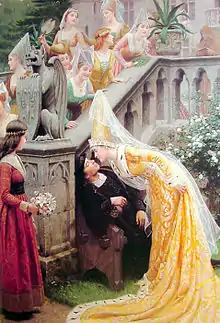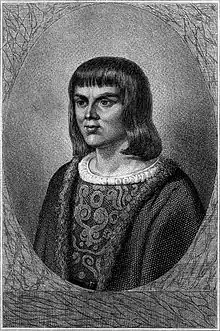Alain Chartier
Alain Chartier (c. 1385 – 1430) was a French poet and political writer.
| French literature |
|---|
| by category |
| French literary history |
| French writers |
|
| Portals |
|
Life
Alain Chartier was born in Bayeux to a family marked by considerable ability. His eldest brother Guillaume became bishop of Paris; and Thomas became notary to the king. Jean Chartier, a monk of St Denis, whose history of Charles VII is printed in vol. III. of Les Grands Chroniques de Saint-Denis (1477), is also said to have been a brother of the poet.[1] Alain studied, as his elder brother had done, at the University of Paris. His earliest poem is the Livre des quatre dames (1416), written after the Battle of Agincourt. This was followed by the Débat du reveille-matin (1422–26?), La Belle Dame sans Mercy (1424), and others.[2]
He followed the fortunes of the dauphin, afterwards Charles VII, acting in the triple capacity of clerk, notary, and financial secretary.[2]
In 1422 he wrote the famous Quadrilogue invectif. The interlocutors in this dialogue are France herself[3] and the three orders of the state. Chartier lays bare the abuses of the feudal army and the sufferings of the peasants. He maintained that the cause of France, though desperate to all appearance, was not yet lost if the contending factions could lay aside their differences in the face of the common enemy.[2]
In 1424 Chartier was sent on an embassy to Germany, and three years later he accompanied to Scotland the mission sent to negotiate the marriage of James I's daughter, Margaret, then not four years old, with the dauphin, afterwards Louis XI. In 1429 he wrote the Livre de l'Espérance, which contains a fierce attack on the nobility and clergy. He was the author of a diatribe on the courtiers of Charles VII. entitled Le Curial, translated into English by William Caxton about 1484.[2]
He died c. 1430. A Latin epitaph, discovered in the 18th century, says, however, that he was Archdeacon of Paris, and declares that he died in the city of Avignon in 1449. This is obviously not authentic, for Alain described himself as a simple "clerc" and certainly died long before 1449.[2]
Interpretation


The story of the famous kiss bestowed by Margaret of Scotland on la précieuse bouche de laquelle sont issus et sortis tant de bons mots et vertueuses paroles ('The invaluable mouth from which issued and which left so many witty remarks and virtuous words') is mythical, for Margaret did not come to France till 1436, after the poet's death; but the story, first told by Guillaume Bouchet in his Annales d'Aquitaine (1524), is interesting, if only as a proof of the high degree of estimation in which the ugliest man of his day was held. Jean de Masies, who annotated a portion of his verse, has recorded how the pages and young gentlemen of that epoch were required daily to learn by heart passages of his Breviaire des nobles. John Lydgate studied him affectionately. His Belle Dame sans mercy was translated into English in the 15th century by Sir Richard Ros, with an introduction of his own; and Clément Marot and Octavien de Saint-Gelais, writing fifty years after his death, find many fair words for the old poet, their master and predecessor.[2]
The English Romantic poet John Keats famously wrote the ballad 'La Belle Dame Sans Merci', using the title from Alain Chartier.[4]
Works
Works in Latin
- Discours au roi (Charles VI) sur les libertés de l'Église (1412?)
- Epistula ad fratrem suum juvenem
- Francigenæ magni, gens fortis et inclita bello...
- Lettre à l'Université de Paris (probably around 1419)
- Premier discours de la mission d'Allemagne
- Second discours de la mission d'Allemagne
- Discours au roi d'Écosse (1428)
- Persuasio ad Pragenses de fide deviantes
- Ad detestationem belli Gallici et suasionem pacis (1423)
- Dialogus familiaris Amici et Sodalis super deplorationem Gallicæ calamitatis (approximately 1427)
- Invectiva ad ingratum amicum
- Invectiva ad invidum et detractorem
- Tractatus de vita curiali
- Lettre sur Jeanne d'Arc (1429)
Works in French
- Le Débat des deux fortunés d'amour (Le Débat du gras et du maigre, approximately 1412/1414)
- Le lay de plaisance (approximately 1412/1414)
- Le Débat du bien et du mal d'amours
- Le Livre des quatre dames (1416)
- Le Quadrilogue invectif (Livre des trois estaz nommé Quadrilogue, 1422)
- Le Bréviaire des nobles (approximately between 1422 and 1426)
- Le Débat de réveille matin de deux amoureux (1423?)
- La Belle Dame sans mercy (1424)
- La Complainte contre la mort de sa dame (1424)
- Le Lay de paix adressé au duc de Bourgogne (approximately between 1424 and 1426)
- Le lay de complainte pour les guerres
- Le Débat du hérault, du vassault et du villain (or Le Débat patriotique, between 1422 and 1425)
- L'excusacion de maistre Alain envers les dames (or La response a la belle dame sans mercy, 1425)
- Le Livre de l'Espérance (or Consolation des trois vertus, 1429)
Notes
References
- Joan E. McRae (2 August 2004). Alain Chartier: The Quarrel of the Belle Dame Sans Mercy. Routledge. p. 3. ISBN 978-1-135-88853-4.
-
 One or more of the preceding sentences incorporates text from a publication now in the public domain: Chisholm, Hugh, ed. (1911). "Chartier, Alain". Encyclopædia Britannica. 5 (11th ed.). Cambridge University Press. p. 953. Endnote:
One or more of the preceding sentences incorporates text from a publication now in the public domain: Chisholm, Hugh, ed. (1911). "Chartier, Alain". Encyclopædia Britannica. 5 (11th ed.). Cambridge University Press. p. 953. Endnote:
- Mancel, Alain Chartier, étude bibliographique et littéraire, 8vo (Paris, 1849)
- D. Delaunay's Étude sur Alain Chartier (1876), with considerable extracts from his writings.
- His works were edited by A. Duchesne (Paris, 1617).
- On Jean Chartier see Vallet de Viriville, "Essais critiques sur les historiens originaux du règne de Charles VIII," in the Bibl. de l'École des Chartes (July–August 1857).
- Delogu, Daisy (2014). Allegorical Bodies : Power and Gender in Late Medieval France. Toronto: University of Toronto Press.
- "La Belle Dame sans Mercy: Introduction | Robbins Library Digital Projects". d.lib.rochester.edu. Retrieved 18 February 2020.
- Alain Chartier, Baudet Herenc and Achille Caulier, Le Cycle de la Belle Dame sans Mercy : une anthologie poétique du XVe siècle (BNF MS FR. 1131), Edition bilingue établie, traduite, présentée et annotée par David F. Hult et Joan E. McRae. Paris : Champion, 2003.
- Biographical references (provided by the International Alain Chartier Society): https://web.archive.org/web/20120426075432/http://www.forlang.mtsu.edu/alain/bibliography.html
